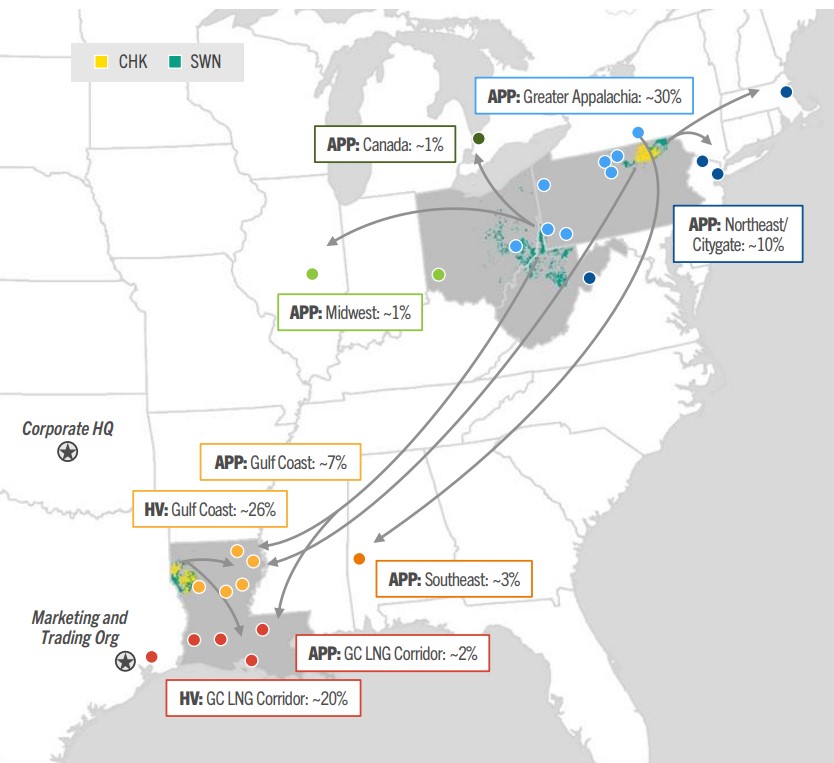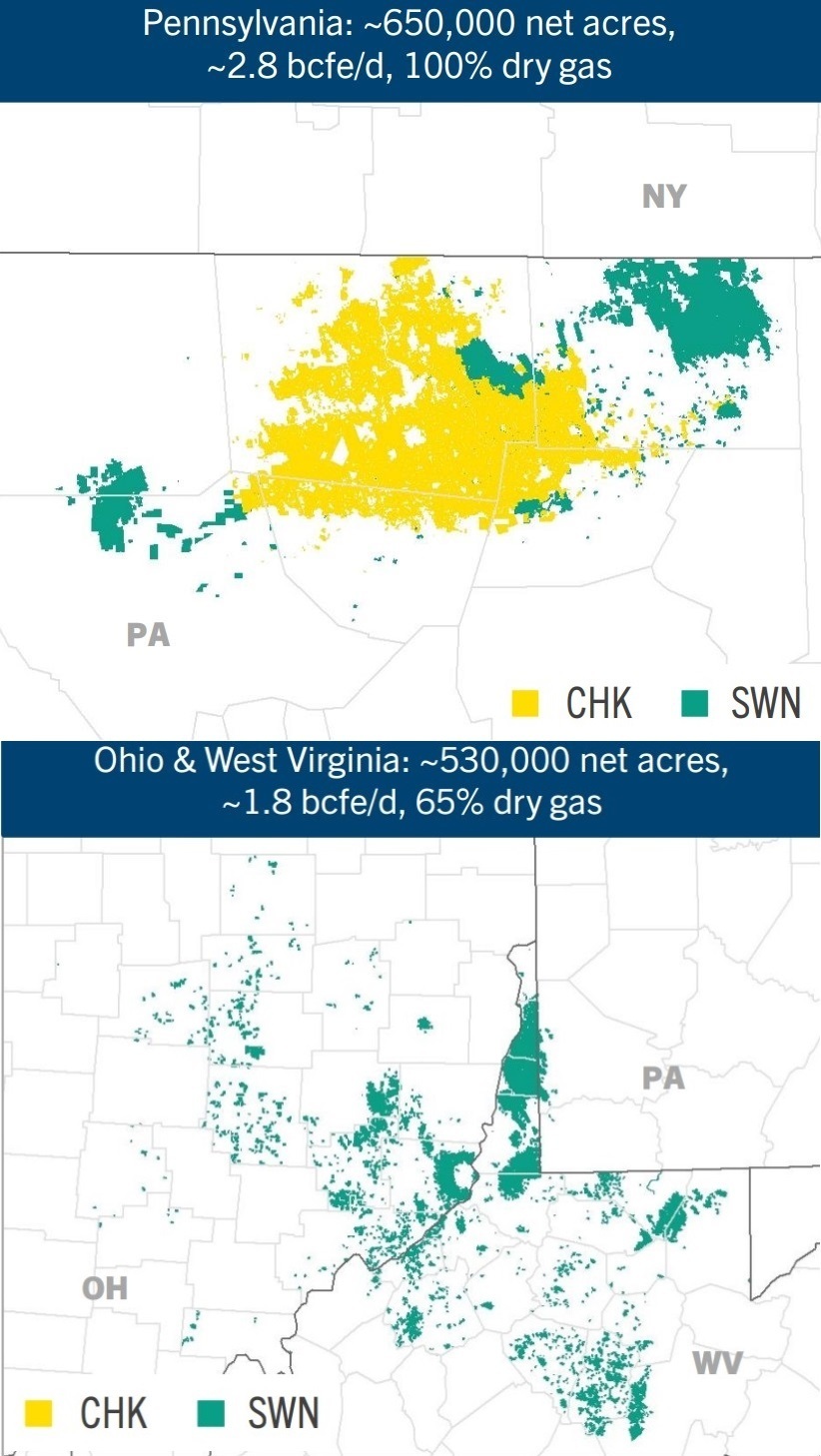
By merging, Chesapeake Energy and Southwestern Energy aim to move up to a fifth of their combined gas production into international LNG markets. (Source: Shutterstock)
Chesapeake Energy and Southwestern Energy plan to scale combined gas marketing and trading capabilities in Houston after closing their $7.4 billion merger.
The primary goal of the marketing and trading business will be to enhance the value of the combined company’s equity natural gas production, while growing access to domestic and international customers, Chesapeake’s President and CEO Nick Dell’Osso said.
“Our scale and balance sheet strength will allow us to serve new domestic customers and compete in rapidly expanding global LNG markets,” Dell’Osso said during a Jan. 11 conference call with analysts.
The combined company—which will assume a new name after the all-stock transaction closes—has an opportunity to “build out a more robust marketing effort that will be unlike what independent gas producers traditionally do,” he said.
With nearly 8 Bcfe/d of production on a pro forma basis, the combined company will have access to over 25 unique natural gas sales points across the Gulf Coast, Appalachia and the Northeastern U.S.

Moving natural gas from the wellhead to where it’s in highest demand with a larger marketing and trading organization should lead to reduced pricing volatility, Dell’Osso said.
“The ability to move supply to the places where it is needed most when it is needed most, and be flexible in how you do that, is super important to customers, as well as to the value that you receive,” he said.
RELATED
Chesapeake, Southwestern to Combine in $7.4B Deal
Global gas
Analysts believe the combined company, which will have an enterprise value of approximately $24 billion, is poised to take advantage of growing global demand for LNG.
U.S. gas producers will play a key role in adding new supply to meet growing global LNG demand; over 50% of new LNG supply on the world market, about 180 million tons per year, will be sourced from the U.S., according to data from Poten & Partners.
East Daley Analytics forecasts hold that gas demand for U.S. LNG exports is expected to grow by 17.4 Bcf/d between 2023 and 2030—stemming from more than a half dozen new LNG export facilities under construction across the Gulf Coast.
Bill Way, president and CEO of Southwestern, said the near-term increase in natural gas demand from LNG actually “created some impetus” for the two gas producers to combine.
Once the merger closes, Chesapeake and Southwestern plan to eventually link up to 20% of their total production to international market pricing—a move that will enhance revenues and limit pricing volatility, Dell’Osso said.
The combined company plans to move about 20% of its total Haynesville output and 2% of its Appalachia production to the Gulf Coast LNG corridor.

Chesapeake has taken a number of steps in recent months toward its goal of being “LNG Ready.” Last year, the Oklahoma City-based E&P sold off its final pieces of oily acreage in the Eagle Ford Shale in three separate deals collectively worth over $3.5 billion.
Chesapeake lined up deals with SilverBow Resources, INEOS Energy and WildFire Energy as buyers for its South Texas assets. Those divestitures positioned Chesapeake as a pure-play natural gas producer.
The company also entered into long-term LNG supply contract agreements with international buyers Gunvor Singapore Pte Ltd. and Vitol Inc., moving its Haynesville gas closer to international pricing.
The agreement with Gunvor is slated to begin in 2027, while the HOA with Vitol is targeted to begin in 2028.
In 2022, Chesapeake signed a deal to deliver 300 MMcf/d of Haynesville gas to the Golden Pass LNG terminal under construction near the Texas-Louisiana border. Golden Pass LNG is a joint venture between QatarEnergy and Exxon Mobil Corp.
RELATED
Shale Outlook: The World Calls on US LNG. Can the Haynesville Answer?
Searching for synergies
Chesapeake and Southwestern aim to realize at least $400 million in annual operational and overhead synergies by combining.
About half of those synergistic savings will come from reducing corporate costs as the combined entity is streamlined and made more efficient, Dell’Osso said during the call.
The pro forma company will also save costs from its overlapping operations in the Haynesville and in Appalachia, which will drive opportunities to share best practices and share common field infrastructure, including assets for gas gathering and water maintenance.

The combined company aims to realize about $130 million in drilling and completion cost savings. Chesapeake has lower drilling cycle times in the Haynesville, and the company aims to deploy its drilling practices into Southwestern’s portfolio.
“Both companies have a pretty interesting approach to completions and we are really eager to get these teams together and optimize around what that completion design looks like,” Dell’Osso said.
Recommended Reading
E&P Highlights: April 22, 2024
2024-04-22 - Here’s a roundup of the latest E&P headlines, including a standardization MoU and new contract awards.
E&P Highlights: Feb. 26, 2024
2024-02-26 - Here’s a roundup of the latest E&P headlines, including interest in some projects changing hands and new contract awards.
Deepwater Roundup 2024: Americas
2024-04-23 - The final part of Hart Energy E&P’s Deepwater Roundup focuses on projects coming online in the Americas from 2023 until the end of the decade.
CNOOC’s Suizhong 36-1/Luda 5-2 Starts Production Offshore China
2024-02-05 - CNOOC plans 118 development wells in the shallow water project in the Bohai Sea — the largest secondary development and adjustment project offshore China.




